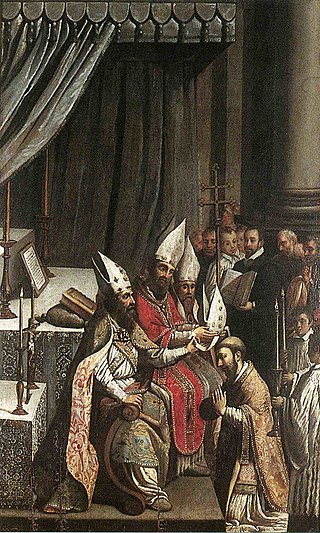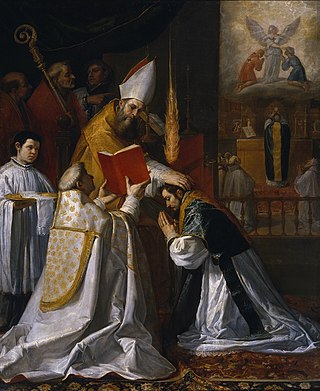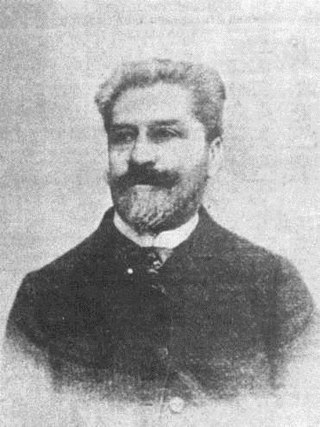
Apostolic succession is the method whereby the ministry of the Christian Church is considered by some Christian denominations to be derived from the apostles by a continuous succession, which has usually been associated with a claim that the succession is through a series of bishops. Those of the Catholic, Eastern Orthodox, Anglican, Church of Sweden, Oriental Orthodox, Church of the East, Hussite, Moravian and Old Catholic traditions maintain that "a bishop cannot have regular or valid orders unless he has been consecrated in this apostolic succession". These traditions do not always consider the episcopal consecrations of all of the other traditions as valid.

In certain Christian denominations, holy orders are the ordained ministries of bishop, priest (presbyter), and deacon, and the sacrament or rite by which candidates are ordained to those orders. Churches recognizing these orders include the Catholic Church, the Eastern Orthodox, Oriental Orthodox, Anglican, Assyrian, Old Catholic, Independent Catholic and some Lutheran churches. Except for Lutherans and some Anglicans, these churches regard ordination as a sacrament.

Stephan A. Hoeller is an American author, lecturer and neo-Gnostic bishop.
In Christian theology, ecclesiology is the study of the Church, the origins of Christianity, its relationship to Jesus, its role in salvation, its polity, its discipline, its eschatology, and its leadership.

Jules-Benoît Stanislas Doinel du Val-Michel, also known simply as Jules Doinel or Tau Valentin II was an archivist and the founder of the first Gnostic church in modern times who claims, that he was consecrated into a new episcopal lineage in a dream by the "Eon Jesus".
Ecclesia Gnostica Catholica (E.G.C.), or the Gnostic Catholic Church, is a Gnostic church organization. It is the ecclesiastical arm of the Ordo Templi Orientis (O.T.O.), an international fraternal initiatory organization devoted to promulgating the Law of Thelema.
Valentinianism was one of the major Gnostic Christian movements. Founded by Valentinus in the 2nd century AD, its influence spread widely, not just within Rome but also from Northwest Africa to Egypt through to Asia Minor and Syria in the East. Later in the movement's history it broke into an Eastern and a Western school. Disciples of Valentinus continued to be active into the 4th century AD, after the Roman Emperor Theodosius I issued the Edict of Thessalonica, which declared Nicene Christianity as the State church of the Roman Empire.
The Charismatic Episcopal Church (CEC), officially the International Communion of the Charismatic Episcopal Church (ICCEC), is a Christian denomination established in 1992. The ICCEC is a part of the Convergence Movement. Within North America, most of the Charismatic Episcopal Church's congregations and missions are located within the Northern, Southeastern, Midwest, and Western United States; it also has a presence in Texas, and in Western Canada.

High church Lutheranism is a movement that began in 20th-century Europe and emphasizes worship practices and doctrines that are similar to those found within Roman Catholicism, Eastern Orthodoxy and Anglo-Catholicism. In the more general usage of the term, it describes the general high church characteristics of Lutheranism in Nordic and Baltic countries such as Sweden, Finland, Estonia and Latvia. The mentioned countries, once a part of the Swedish Empire, have more markedly preserved Catholic traditions.
Gnosticism in modern times includes a variety of contemporary religious movements, stemming from Gnostic ideas and systems from ancient Roman society. Gnosticism is an ancient name for a variety of religious ideas and systems, originating in Jewish-Christian milieux in the first and second century CE.
Catholicity is a concept of pertaining to beliefs and practices that are widely accepted by numerous Christian denominations, most notably by those Christian denominations that describe themselves as catholic in accordance with the Four Marks of the Church, as expressed in the Nicene Creed formulated at the First Council of Constantinople in 381: "[I believe] in one, holy, catholic, and apostolic Church." The English adjective catholic is derived from the Ancient Greek adjective καθολικός, meaning "general", "universal". Thus, "catholic" means that in the Church the wholeness of the Christian faith, full and complete, all-embracing, and with nothing lacking, is proclaimed to all people without excluding any part of the faith or any class or group of people. An early definition for what is "catholic" was summarized in what is known as the Vincentian Canon in the 5th century Commonitory: "what has been believed everywhere, always, and by all."
A Gnostic Mass is a liturgical Mass administered by a Gnostic church. Several such churches exist, each with its own version of the Mass. Some of these are:
Ecclesia de Eucharistia is an encyclical by Pope John Paul II published on April 17, 2003. Its title, as is customary, is taken from the opening words of the Latin version of the text, which is rendered in the English translation as "The Church draws her life from the Eucharist". He discusses the centrality of the Eucharist to the definition and mission of the Church and says he hopes his message will "effectively help to banish the dark clouds of unacceptable doctrine and practice, so that the Eucharist will continue to shine forth in all its radiant mystery." He explored themes familiar from his earlier writings, including the profound connection between the Eucharist and the priesthood. It drew as well on his personal experiences saying Mass.

The sacrament of holy orders in the Catholic Church includes three orders: bishops, priests, and deacons, in decreasing order of rank, collectively comprising the clergy. In the phrase "holy orders", the word "holy" means "set apart for a sacred purpose". The word "order" designates an established civil body or corporation with a hierarchy, and ordination means legal incorporation into an order. In context, therefore, a group with a hierarchical structure that is set apart for ministry in the Church.

JeanBricaud, also known as Tau Jean II, was a French student of the occult and esoteric matters. Bricaud was heavily involved in the French neo-Gnostic movement. He was consecrated a Gnostic bishop on 21 July 1913 by bishop Louis-Marie-François Giraud. He was the Patriarch of the Église Gnostique Universelle and a central figure in the various lines of the apostolic succession of subsequent Gnostic churches, as well as a spiritual heir of Jules Doinel. From 1916 he was head of the Ordre Martiniste. He was a friend of the occultists Papus and August Vandekerkhove.
This is a glossary of terms used within the Catholic Church. Some terms used in everyday English have a different meaning in the context of the Catholic faith, including brother, confession, confirmation, exemption, faithful, father, ordinary, religious, sister, venerable, and vow.
A particular church is an ecclesiastical community of followers headed by a bishop, as defined by Catholic canon law and ecclesiology. A liturgical rite, a collection of liturgies descending from shared historic or regional context, depends on the particular church the bishop belongs to. Thus the term "particular church" refers to an institution, and "liturgical rite" to its ritual practices.
In the Catholic Church, communicatio in sacris, also called communicatio in divinis or communicatio in ritibus, designates the regulations for the partaking of a Catholic person to a non-Catholic sacrament or liturgical celebration, or for the partaking of a non-Catholic person to a Catholic sacrament or liturgical celebration. The expression is also used to refer to said acts of partaking themselves.

The Gnostic Church of France is a neo-Gnostic Christian organisation formed by Jules Doinel in 1890, in France. It is the first Gnostic church in modern times.
Tau Malachi is an American neo-Gnostic religious leader and writer. He is currently the Gnostic Apostle of Ecclesia Pistis Sophia, also known as The Fellowship.










